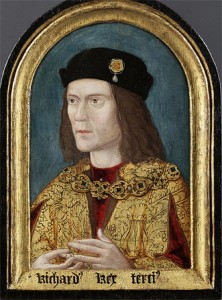 On this day in history, 2nd October…
On this day in history, 2nd October…
1452 – Birth of Richard III at Fotheringhay Castle, Northamptonshire. Richard was the youngest surviving child of Richard, 3rd Duke of York, and Cecily Neville. Richard claimed the English throne in June 1483, claiming that his brother Edward IV’s sons were illegitimate because Edward had been pre-contracted to another woman when he married Elizabeth Woodville. Richard III was killed at the Battle of Bosworth on 22nd August 1485 and Henry Tudor claimed the throne as Henry VII. See “22 August 1485 – The Battle of Bosworth”
1501 – Catherine of Aragon arrived in England, landing at Plymouth in Devon. She had come to England to marry Prince Arthur, the heir to the throne of England. See “27 September 1501 – Catherine of Aragon Leaves Spain for England”
1514 – Mary Tudor, sister of Henry VIII, set off from Dover to sail to France to marry King Louis XII. She was 18 and he was 52 and not in the best of health. They married on the 9th October 1514 but the marriage was short-lived as Louis died in January 1515. Mary went on to marry Charles Brandon, the Duke of Suffolk, on the 3rd March 1515.
1518 – Treaty of London – Cardinal Wolsey’s treaty of “Universal” peace between France and England was signed. See “The Death of Cardinal Wolsey” for more information on Wolsey.
Thanks to Nasim for reminding me of the following…
1521 – Pope Leo X was given Henry VIII’s “Assertio septem sacramentorum” or “Defence of the Seven Sacraments” in Rome. This work led to Henry VIII being proclaimed “Fidei Defensor” or “Defender of the Faith”.
1528 – Publication of William Tyndale’s “The Obedience of the Christian Man and How Christian Rulers Ought to Govern” published by William Tyndale. This book said that rulers were accountable to God, not the Pope. Anne Boleyn owned a copy of this book, as well as Tyndale’s New Testament, and it is this book which she intended to show Henry VIII, marking key passages for his attention. The book got into his hands when it was confiscated from George Zouche, suitor of Anne Gainsford who had borrowed it from her mistress, Anne Boleyn. Henry VIII read it and declared “This book is for me and all kings to read.”
1536 – Start of the Lincolnshire Rising, the beginning of the Pilgrimage of Grace. It was sparked off by a sermon at evensong on the 1st October at St James’s Church, Louth. Mary Polito, author of “Governmental Arts in Tudor England” writes:-
“The first rising occurred at Louth on October 2, 1536, when the registrar arrived from the bishop to carry out the visitation; the commons, led by a shoemaker named Nicholas Melton – soon to be famed as Captain Cobbler – seized the registrar, burned his papers and forced the registrar and assembled priests to swear an oath to be true to the rebels and their cause. They then marched to Legbourne nunnery and took captive the royal commissioners who were at work there.”
Legbourne nunnery had been formally suppressed a few weeks earlier.